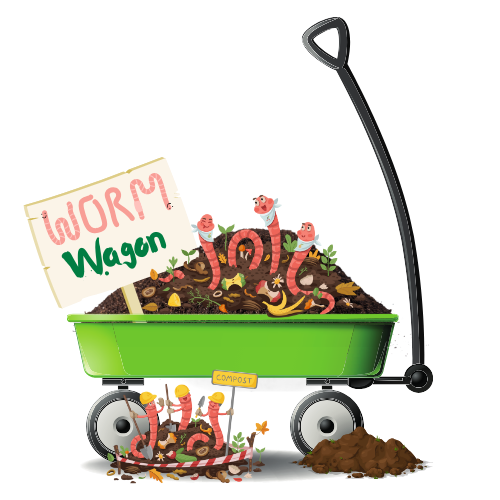Welcome back to The Worm Wagon! The question on everyone’s mind when they first start their Worm adventure… How do I choose the right worms for my bin? The type of worms you select can significantly impact the success of your composting efforts, so let’s explore the best options and their benefits.
Why Worm Choice Matters
Not all worms are created equal when it comes to composting. The worms used in vermicomposting are different from the common earthworms you might find in your garden. Composting worms thrive in the rich, moist environment of a worm bin and are highly efficient at breaking down organic matter.
The Best Worms for Vermicomposting
1. Red Wigglers (Eisenia fetida)
• Description: Red wigglers are the most popular choice for vermicomposting. They are small, red worms that thrive in decaying organic matter and manure.
• Benefits:
• Highly efficient at breaking down organic waste.
• Reproduce quickly, increasing your worm population and composting efficiency.
• Tolerant of a wide range of temperatures and conditions.
• Best For: Beginners and experienced composters alike due to their hardiness and prolific nature.
2. European Nightcrawlers (Eisenia hortensis)
• Description: Larger than red wigglers, European nightcrawlers are also excellent composters and can burrow deeper into the soil.
• Benefits:
• Great for both composting and use as fishing bait.
• Produce rich worm castings that improve soil structure and fertility.
• Can tolerate slightly cooler temperatures compared to red wigglers.
• Best For: Those looking for dual-purpose worms (composting and fishing) and gardeners in cooler climates.
3. Blue Worms (Perionyx excavatus)
• Description: Also known as Indian blue worms, these worms are slightly smaller and more active than red wigglers.
• Benefits:
• Extremely efficient at breaking down organic waste quickly.
• Thrive in warm, tropical climates.
• Best For: Composters in warm climates looking for fast composting results.
4. African Nightcrawlers (Eudrilus eugeniae)
• Description: These large, robust worms are known for their impressive composting capabilities and rapid growth rates.
• Benefits:
• Produce high-quality worm castings.
• Efficient at breaking down a wide variety of organic materials.
• Can be used for composting and as fishing bait.
• Best For: Experienced composters and those in warm climates.
How to Choose the Right Worms for Your Bin
When selecting worms for your vermicomposting bin, consider the following factors:
• Climate: Choose worms that are well-suited to your local climate. Red wigglers and European nightcrawlers are versatile and can handle a range of temperatures, while blue worms and African nightcrawlers prefer warmer conditions.
• Purpose: Determine your primary goal. If you’re focused solely on composting, red wigglers are an excellent choice. For dual purposes like composting and fishing, consider European or African nightcrawlers.
• Experience Level: If you’re new to vermicomposting, starting with red wigglers is a safe bet due to their hardiness and ease of care.
Where to Get Your Worms
You can purchase composting worms from local garden centers, bait shops, or reputable online suppliers. Ensure you buy from a source that provides healthy, active worms and offers guidance on starting your vermicomposting journey.
Final Thoughts
Choosing the right worms is a key step in setting up a successful vermicomposting system. By selecting the appropriate species for your needs and environment, you’ll set yourself up for composting success and a healthier garden.
Stay tuned for more tips, tutorials, and stories as we continue to explore the wonderful world of worm farming. Happy composting!
Until next time, 🪱 Worm on!🪱
Lindsay








Leave a comment